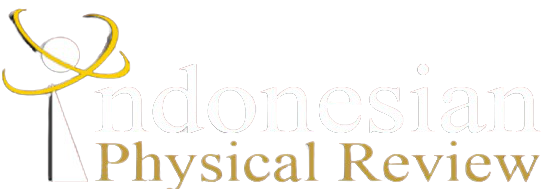REFORMULATION OF GEOMETRIC OPTICS WITHIN THE FRAMEWORK OF ABELIAN U(1) GAUGE THEORY: A NOVEL APPROACH TO UNDERSTANDING LIGHT PROPAGATION
DOI:
10.29303/ipr.v8i2.464Downloads
Abstract
This study introduces a reformulation of geometrical optics through the framework of Abelian U(1) gauge theory. By leveraging this novel approach, phase equations are derived, serving as the cornerstone for determining the trajectories of light rays. The proposed formulation is validated through simulations of light propagation in diverse scenarios, including homogeneous refractive index media, vacuum, anisotropic materials, and optical metamaterials. These results underscore the versatility and predictive power of this gauge-theoretic approach, opening new avenues for exploring and modeling complex optical phenomena.
Keywords:
Geometrical optics Abelian ð‘ˆ(1) gauge theory Light propagationReferences
M. Born and E. Wolf, Principles of optics, 7th ed. Cambridge University Press, 1999.
E. Hecht, Optics, 4th ed. Pearson Education, Inc., 2002.
B. D. Guenther, Modern Optics Simplified, 1st ed. Oxford University Press, 2020.
A. V. Fedorov, C. A. Stepa, A. V. Korolkova, M. N. Gevorkyan, and D. S. Kulyabov, “Methodological derivation of the eikonal equation,†Discret. Contin. Model. Appl. Comput. Sci., vol. 31, no. 4, pp. 399–418, 2023.
L. D. Landau and E. M. Lifshitz, Electrodynamics of Continuous Media, 2nd ed. Pergamon Press, 1984.
K. V Shajesh, “Eikonal Approximation.†[Online]. Available: https://www.nhn.ou.edu/~shajesh/eikonal/sp.pdf
A. F. Ranada, “Topological electromagnetism,†J. Phys. 4 Math. Gen, vol. 25, pp. 1621–1641, 1992.
F. Liu and J. Li, “Gauge field optics with anisotropic media,†Phys. Rev. Lett., vol. 114, no. 10, Mar. 2015.
D. Delphenich, “On geodesics of gradient-index optical metrics and the optical-mechanical analogy,†2020. [Online]. Available: https://arxiv.org/abs/2002.04390
D. K. Sharma and S. K. Pathak, “Propagation characteristics of an extremely anisotropic metamaterial loaded helical guide,†Opt. Express, vol. 24, no. 26, p. 29521, Dec. 2016.
M. Hadi and S. Muliyono, “Gauge Theory in a Vacuum Space-time,†Indones. Phys. Rev., vol. 7, no. 1, pp. 143–151, 2024.
S. Weinberg, The Quantum Theory of Fields Volume I Foundations. 1995.
I. J. Aitchison and A. J. Hey, Gauge Theories Particle Physics, VOLUME 1 From Relativistic Quantum Mechanics to QED. 2013.
S. Alsid and M. Serna, “Unifying Geometrical Representations of Gauge Theory,†Found. Phys., vol. 45, no. 1, pp. 75–103, Jan. 2015.
D. E. Ruiz and I. Y. Dodin, “Lagrangian geometrical optics of nonadiabatic vector waves and spin particles,†Phys. Lett. Sect. A Gen. At. Solid State Phys., vol. 379, no. 38, pp. 2337–2350, Aug. 2015.
P. Fontana, “Quantum simulations of gauge theories and topological phases,†2021. [Online]. Available: https://iris.sissa.it/retrieve/323d4c9d-5fd0-45a4-9186-758b91a12ed4/thesis_v3__external_referees_corrections_.pdf
K. H. Yang, “Gauge Transformations and Quantum Mechanics Gauge Invariant Interpretation of Quantum Mechanics,†Ann. Phys. (N. Y)., vol. 96, pp. 62–96, 1976.
M. J. D. Hamilton, Mathematical Gauge Theory. Springer International Publishing, 2017.
Y. Chen et al., “Non-Abelian gauge field optics,†Nat. Commun., vol. 10, no. 1, Dec. 2019.
S. I. Maslovski and H. Mariji, “Envelope Dyadic Green’s Function for Uniaxial Metamaterials,†Feb. 2018. [Online]. Available: http://arxiv.org/abs/1802.05899
C. A. Dartora et al., “Lagrangian-Hamiltonian formulation of paraxial optics and applications: Study of gauge symmetries and the optical spin Hall effect,†Phys. Rev. A - At. Mol. Opt. Phys., vol. 83, no. 1, Jan. 2011.
A. H. Gevorgyan and M. S. Rafayelyan, “Light propagation in anisotropic metamaterials. I. Dispersion surfaces,†J. Contemp. Phys., vol. 48, no. 6, pp. 276–284, 2013.
T. Honjo, K. Inoue, and H. Takahashi, “Differential-phase-shift quantum key distribution experiment with a planar light-wave circuit Mach–Zehnder interferometer,†Opt. Lett., vol. 29, no. 23, p. 2797, 2004.
S. K. Debnath and M. P. Kothiyal, “Experimental study of the phase-shift miscalibration error in phase-shifting interferometry: Use of a spectrally resolved white-light interferometer,†Appl. Opt., vol. 46, no. 22, pp. 5103–5109, 2007.
J. Aizenberg, J. A. Rogers, K. E. Paul, and G. M. Whitesides, “Imaging profiles of light intensity in the near field: applications to phase-shift photolithography,†Appl. Opt., vol. 37, no. 11, p. 2145, 1998.
M. L. Boas, Mathematical Methods in Physical the Physical Sciences, vol. 57, no. 1. John Wiley & Son, 2006.
M. Masujima, Applied Mathematical Methods in Theoretical Physics. Wiley-VCH Verlag GmbH&Co.KGaA, 2005. doi: 10.1002/9783527627745.
M. R. Spiegel, Vector Analysis and an Introduction to Tensor Analysis. McGraw-Hill, Inc., 1959.
D. Tong, “Gauge Theory,†2018. doi: 10.1007/978-3-319-14765-9_14.
S. S. Sastry, Introductory Methods of Numerical Analysis, Fifth., vol. 4, no. 1. PHI Learning Private Limited, New Delhi, 2012.
License

This work is licensed under a Creative Commons Attribution-NonCommercial-ShareAlike 4.0 International License.
Authors who publish with Indonesian Physical Review Journal, agree to the following terms:
- Authors retain copyright and grant the journal right of first publication with the work simultaneously licensed under a Creative Commons Attribution-ShareAlike 4.0 International Licence (CC BY SA-4.0). This license allows authors to use all articles, data sets, graphics, and appendices in data mining applications, search engines, web sites, blogs, and other platforms by providing an appropriate reference. The journal allows the author(s) to hold the copyright without restrictions and will retain publishing rights without restrictions.
- Authors are able to enter into separate, additional contractual arrangements for the non-exclusive distribution of the journal's published version of the work (e.g., post it to an institutional repository or publish it in a book), with an acknowledgment of its initial publication in Indonesian Physical Review Journal.
- Authors are permitted and encouraged to post their work online (e.g., in institutional repositories or on their website) prior to and during the submission process, as it can lead to productive exchanges, as well as earlier and greater citation of published work (See The Effect of Open Access).





